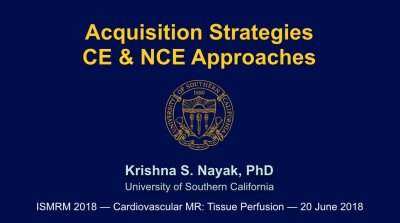|
Sunrise Session
Advanced Techniques in Cardiovascular MR: Tissue Perfusion |
|
Advanced Techniques in Cardiovascular MR: Tissue Perfusion
Sunrise Session
ORGANIZERS: James Carr, Bernd Wintersperger
Wednesday, 20 June 2018
| S02 |
07:00 - 07:50 |
Moderators: Amedeo Chiribiri |
Skill Level: Intermediate
Session Number: S-W-02
Overview
This course will review advanced techniques for characterizing myocardial tissue abnormalities and measuring function. The course will also overview rapid acquisition approaches for assessing cardiac disease as well as exploring multimodality strategies for imaging the heart.
Target Audience
Attendees, both physicians and scientists, who have intermediate-to-advanced knowledge of cardiac MR methodology and wish to learn about evolving approaches to assessing cardiac disease and become familiar with emerging imaging technologies.
Educational Objectives
As a result of attending this course, participants should be able to:
-Describe novel techniques for assessing cardiac function and evaluating myocardial function;
-Summarize rapid acquisition strategies for comprehensive MR assessment of the heart; and
-Explain multimodality approaches to assessing cardiac pathology.
07:00
|
 |
 Acquisition Strategies: Contrast-Enhanced & NCE Approaches Acquisition Strategies: Contrast-Enhanced & NCE Approaches
Krishna Nayak
This talk will briefly review CMR perfusion imaging strategies, including contrast-enhanced first-pass imaging (most commonly used method), and non-contrast enhanced blood oxygen level dependent imaging and arterial spin labeling imaging. Then we will cover how to image the myocardium with high time and signal-to-noise ratio efficiency. This will include balanced SSFP strategies, EPI strategies, and simultaneous multi-slice imaging.
|
07:25
|
|
 Understanding Contrast Mechanisms, Contrast Agents & Perfusion Models Understanding Contrast Mechanisms, Contrast Agents & Perfusion Models
Smita Sampath
Quantitative cardiac perfusion MRI is a non-invasive radiation-free technique that can estimate absolute myocardial blood flow (MBF) and myocardial perfusion reserve (MPR), which are known to be good indicators of ischemic burden in CAD patients, as well as of hemodynamic significance of stenotic lesions. Further, there is growing evidence that MBF and MPR may be sensitive biomarkers of microvascular ischemia. A typical perfusion MRI experiment involves the administration of contrast agents to capture the wash-in wash-out characteristics of the arterial input function and the tissue output function at rest and during pharmacologically induced stress. The functions are then modeled using either compartmental modeling approaches or deconvolution approaches to extract myocardial blood flow at the two experimental states from which myocardial perfusion reserve is quantitated. This module will focus on presenting contrast agents and mechanisms involved, typical protocols, sequences and stress agents used, as well as discuss in detail the perfusion models used for quantitative data analysis.
|
07:50
|
|
Adjournment & Meet the Teachers |
|
| Back |
| The International Society for Magnetic Resonance in Medicine is accredited by the Accreditation Council for Continuing Medical Education to provide continuing medical education for physicians. |


